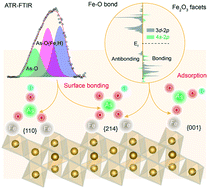Arsenic adsorption on hematite facets: spectroscopy and DFT study†
Abstract
Hematite (Fe2O3) nanoparticles are omnipresent in nature and of great importance in controlling the environmental fate of arsenic (As). Fe2O3 facets exhibit a significant effect on the surface reactivity; however, the underlying chemical driving force that controls Fe2O3 facet reactivity towards As(III/V) adsorption remains poorly defined. Here, As(III/V) adsorption on the Fe2O3 {001}, {110}, and {214} facets was explored to understand the facet-dependent binding mechanisms. Multidisciplinary spectroscopic characterization and density functional theory (DFT) calculations revealed monodentate mononuclear As(III/V) complexes on the {001} facet, and bidentate binuclear surface complexes on the {110} and {214} facets. Different adsorption configurations were ascribed to the chemical diversity in surface active sites, where the under-coordinated Fe atoms served as Lewis acid sites. The strength of Lewis acid sites determined the facet-dependent reactivity towards As(III/V) adsorption. Partial density of states (PDOS) and crystal orbital Hamilton population (COHP) analysis suggested that the surface bonding was attributed to the interactions between the Fe(3d and 4s) and O(2p) orbitals. The experimental and theoretical results indicate that the intrinsic nature of facet-dependent mechanism lies in the surface site coordination and its bonding strengths. The mechanistic insights into the bonding chemistry on facets improve our ability in predicting the behavior of environmental contaminants at the solid/liquid interface.



 Please wait while we load your content...
Please wait while we load your content...